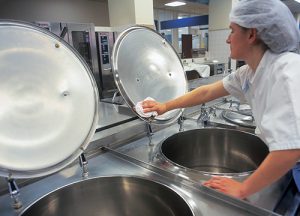In your working environment, a hygienic, healthy and productive work space is paramount – both for the final product and for the people who produce it. Protecting the people and processes from contamination helps nurture this environment. Workers’ hand hygiene compliance is a big concern to many employer and can contribute to contamination events.
- 89% of foodborne outbreaks analysed by the U.S. over a 23-year period specifically implicated or cited activities that implied food worker’s hands as a factor in pathogen transmission1
- ~70% of all foodborne disease is due to viruses spread by direct or indirect contact with infected individuals2. Employee behaviour and poor personal hygiene are the key risk factors associated with non-compliance2
Understanding the science of people

Kimberly-Clark Professional® understand how important it is to have an audit ready facility but more importantly the need to have an enhanced safety culture where both the physical environment and workers behaviours are influenced providing you with the ongoing positive outcomes you need. The journey to a work safety culture should start not only by understanding the science of food, but also the science of people.
Leveraging the power of behavioral science Kimberly-Clark Professional® has helped reduce the number of contaminated hands by 95%.
Food Processing facility hygiene and safety opportunities
- Product Changeover
– Carbonised waste: Removal of carbonised waste from high temperature equipment is essential for keeping it in operating condition and reducing the potential for cross-contamination between production runs.
– Surface wiping: In-production spills needs to be quickly and effectively removed to prevent build-up and contamination. - Deep Cleaning
– Steam cleaning: Regular steam cleaning of surfaces can be critical to keeping high risk area’s sanitary.
– Pressure washing: Routine high intensity cleaning of surface and machinery is required to maintain standards of hygiene and mechanical efficiency.
– Intricate cleaning: Requires conformable wipers that are effective in the tightest areas. - Hand Hygiene
– Washing & drying: Good provision for hand hygiene is essential within the food manufacturing area as complacency can lead to potential hygiene risks.
– Sanitising: Avoiding cross contamination of food stuffs is critical in high risk food processing areas. - In Process
– Production: During production, protection of both the process and the worker are important. - Debris and spillages
– Dry debris: Cleaning dust and dry debris is an essential foundation in any food process, preventing build-up that can result in production delays or poor sanitation.
– Wet spillage: Prompt removal of spillages keeps hygiene standards high and reduces the risks from slip and trip hazards.

Harness the power of C.H.E.S.S.™ to provide a positive experience
Create a food safety culture by addressing these five factors through C.H.E.S.S™. Kimberly-Clark studied hygiene needs around the globe for over 100 years and discovered that the key to an exceptional experience revolves around the five key factors. Their branded solutions work hard every day and can help you embed a food safety culture.
- Cleanliness – Cleaning is in the top 10 reasons for Food Audit non conformance3
- Hygiene – Proper hand hygiene can help in reducing foodborne outbreaks4
- Efficiency – Utilising an efficient hand towel format results in less changeovers required
- Sustainability – A commitment to the environment helps reduce waste and enables you to meet or exceed industry guidelines
- Satisfaction – Uncover where your facility is in the food safety continuum to help improve compliance and efficacy of contamination control practices
References
Source 1: FDA, “Evaluation of Risks Related to Microbiological Contamination of Ready-to-eat Food by Food Preparation Workers and the Effectiveness of Interventions to Minimize Those Risks”, 1999
Source 2: FDA, 2009
Source 3: https://haccpmentor.com/audits/top-10-food-non-conformances
Source 4: From the World Health organisation. https://who.insomnation.com/sites/default/_les/pdf/fan_hand%20wash2.pdf











